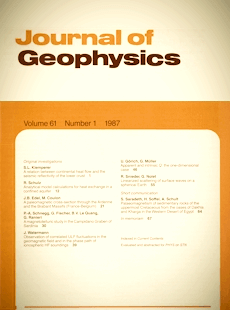An upper bound on lithosphere thickness from glacio-isostatic adjustment in Fennoscandia
Article Sidebar

Vols. 1-18 (1924-1944), ISSN 0044-2801
Main Article Content
Abstract
The three-layer Maxwell half-space model of the Earth and a disk-load approximation of the Weichselian deglaciation history of Fennoscandia are used to calculate glacio-isostatic adjustment for this region. The calculations include the effects of deglaciation-induced geoid perturbations and eustatic sea-level rise and regard (1) lithosphere thickness, (2) asthenosphere viscosity and (3) ice thickness as the free model parameters. Numerical values of parameters (1)-(3) are estimated by calculating the past land uplift and present land-uplift rate observed in central Sweden (glaciation centre) and the past land uplift and past land tilt observed in southern Finland (glaciation margin). The uniqueness of the estimates and their sensitivity to uncertainties in (4) subasthenosphere viscosity, (5) ice cross-section and (6) deglaciation time are also assessed. The principal result of the investigation is that it suggests an upper bound of 80 km on the thickness of the Fennoscandian lithosphere.
 ARK: https://n2t.net/ark:/88439/y082218
ARK: https://n2t.net/ark:/88439/y082218
Permalink: https://geophysicsjournal.com/article/93
Article Details
References
Andersen, B.G. (1981) Late Weichselian ice sheets in Eurasia and Greenland. In: Denton, G.H., Hughes, T.J. (Eds.) The last great ice sheets, pp. 1-65. John Wiley, New York
Andrews, J.T. (1970) A geomorphological study of post-glacial uplift with particular reference to Arctic Canada. London: Institute of British Geographers
Balling, N. (1980) The land uplift in Fennoscandia, gravity field anomalies and isostasy. In: Marner, N.-A. (Ed.) Earth rheology, isostasy, and eustasy, pp. 297-321. John Wiley, Chichester
Bemmelen, R.W. van, Berlage, H.P., jr. (1935) Versuch einer mathematischen Behandlung geotektonischer Bewegungen unter besonderer Beriicksichtigung der Undationstheorie. Gerlands Beitr. Geophys. 43:19-55
Bullen, K.E. (1963) An introduction to the theory of seismology, 3rd edn. Cambridge University Press
Cathles, L.M. (1975) The viscosity of the earth's mantle. Princeton University Press
Daly, R.A. (1934) The changing world of the ice age. Yale University Press
Donner, J. (1980) The determination and dating of synchronous Late Quaternary shorelines in Fennoscandia. In: Marner, N.-A. (Ed.) Earth rheology, isostasy, and eustasy, pp. 285-293. John Wiley, Chichester
Eronen, M. (1983) Late Weichselian and Holocene shore displacement in Finland. In: Smith, D.E., Dawson, A.G. (Eds.) Shorelines and isostasy, pp. 183-207. Academic Press, London
Farrell, W.E. (1972) Deformation of the earth by surface loads. Rev. Geophys. Space Phys. 10:761-797
Farrell, W.E., Clark, J.A. (1976) On postglacial sea level. Geophys. J. R. Astron. Soc. 46:647-667
Geer, E.H. de (1954) Skandinaviens geokronologi. Geol. Faren. Stockholm Farh. 76:299-329
Haskell, N.A. (1935) The motion of a viscous fluid under a surface load. Physics 6:265-269
Hyviirinen, H., Eronen, M. (1979) The Quaternary history of the Baltic, the northern part. Acta Univ. Upsala Symp. Upsala Ann. Quing. Cel. 1:7-27
Kiiiiriiiinen, E. (1966) The second levelling of Finland in 1935-1955. Publ. Finn. Geod. Inst. 61:1-313
Liden, R. (1938) Den senkvartara strandforskjutningens forlopp och kronologi i Angermanland. Geol. Faren. Stockholm Farh. 60:397-404
McConnell, R.K., jr. (1968) Viscosity of the mantle from relaxation time spectra of isostatic adjustment. J. Geophys. Res. 73:7089-7105
Nadai, A. (1963) Theory offlow and fracture of solids, Vol. 2. McGraw-Hill, New York
Nansen, F. (1921) The strandflat and isostasy. Avh. Norske Vid.-Akad. Math.-Naturvid. Kl. 11:1-313
Niskanen, E. (1939) On the upheaval ofland in Fennoscandia. Ann. Acad. Sci. Fenn. Ser. A 53:1-30
Niskanen, E. (1943) On the deformation of the earth's crust under the weight of a glacial ice-load and related phenomena. Ann. Acad. Sci. Fenn. Ser. A3 7:1-59
Niskanen, E. (1949) On the elastic resistance of the earth's crust. Ann. Acad. Sci. Fenn. Ser. A3 21:1-23
Nye, J.F. (1952) A method of calculating the thickness of the ice-sheets. Nature 169:529-530
Orowan, E. (1949) Contribution to discussion at joint meeting of the British Glaciological Society, the Rheologists' Club and the Institute of Metals. J. Glaciol. 1:231-236
Parsons, B.E. (1972) Changes in the earth's shape. Ph.D. thesis. Department of Geodesy and Geophysics, Cambridge University
Paterson, W.S.B. (1981) The physics of glaciers, 2nd edn. Pergamon Press, Oxford
Peltier, W.R. (1984) The thickness of the continental lithosphere. J. Geophys. Res. 89:11303-11316
Peltier, W.R., Andrews, J.T. (1976) Glacial-isostatic adjustment - 1. The forward problem. Geophys. J. R. Astron. Soc. 46:605-646
Quinlan, G., Beaumont, C. (1982) The deglaciation of Atlantic Canada as reconstructed from the postglacial relative sea-level record. Can. J. Earth Sci. 19:2232-2246
Sabadini, R., Yuen, D.A., Portney, M. (1986) The effects of upper-mantle lateral heterogeneities on postglacial rebound. Geophys. Res. Lett. 13:337-340
Sauramo, M. (1958) Die Geschichte der Ostsee. Ann. Acad. Sci. Fenn. Ser. A3 51:1-522
Sneddon, I.A. (1951) Fourier transforms. McGraw-Hill, New York
Terazawa, K. (1916) On periodic disturbance of level arising from the load of neighbouring oceanic tides. Phil. Trans. R. Soc. London Ser. A 217:35-50
Walcott, R.I. (1970) Isostatic response to loading of the crust in Canada. Can. J. Earth Sci. 7:716-727
Walcott, R.I. (1972) Past sea levels, eustasy and deformation of the earth. Quat. Res. 2:1-14
Walcott, R.I. (1980) Rheological models and observational data of glacioisostatic rebound. In: Momer, N.A. (Ed.) Earth rheology, isostasy, and eustasy, pp. 3-10. John Wiley, Chichester
Wolf, D. (1984) The relaxation of spherical and flat Maxwell earth models and effects due to the presence of the lithosphere. J. Geophys. 56:24-33
Wolf, D. (1985a) The normal modes of a layered, incompressible Maxwell half-space. J. Geophys. 57:106-117
Wolf, D. (1985b) An improved estimate of lithospheric thickness based on a reinterpretation of tilt data from Pleistocene Lake Algonquin. Can. J. Earth Sci. 22:768-773
Wolf, D. (1986a) Glacio-isostatic adjustment in Fennoscandia revisited. J. Geophys. 59:42-48
Wolf, D. (1986b) A method of calculating lithosphere thickness from observations of deglacial land uplift and tilt. J. Geophys. 60:28-32
Wolf, D. (1986c) On deglaciation-induced perturbations of the geoid. Can. J. Earth Sci. 23:269-272
Wu, P., Peltier, W.R. (1983) Glacial isostatic adjustment and the free air gravity anomaly as a constraint on deep mantle viscosity. Geophys. J. R. Astron. Soc. 74:377-449











